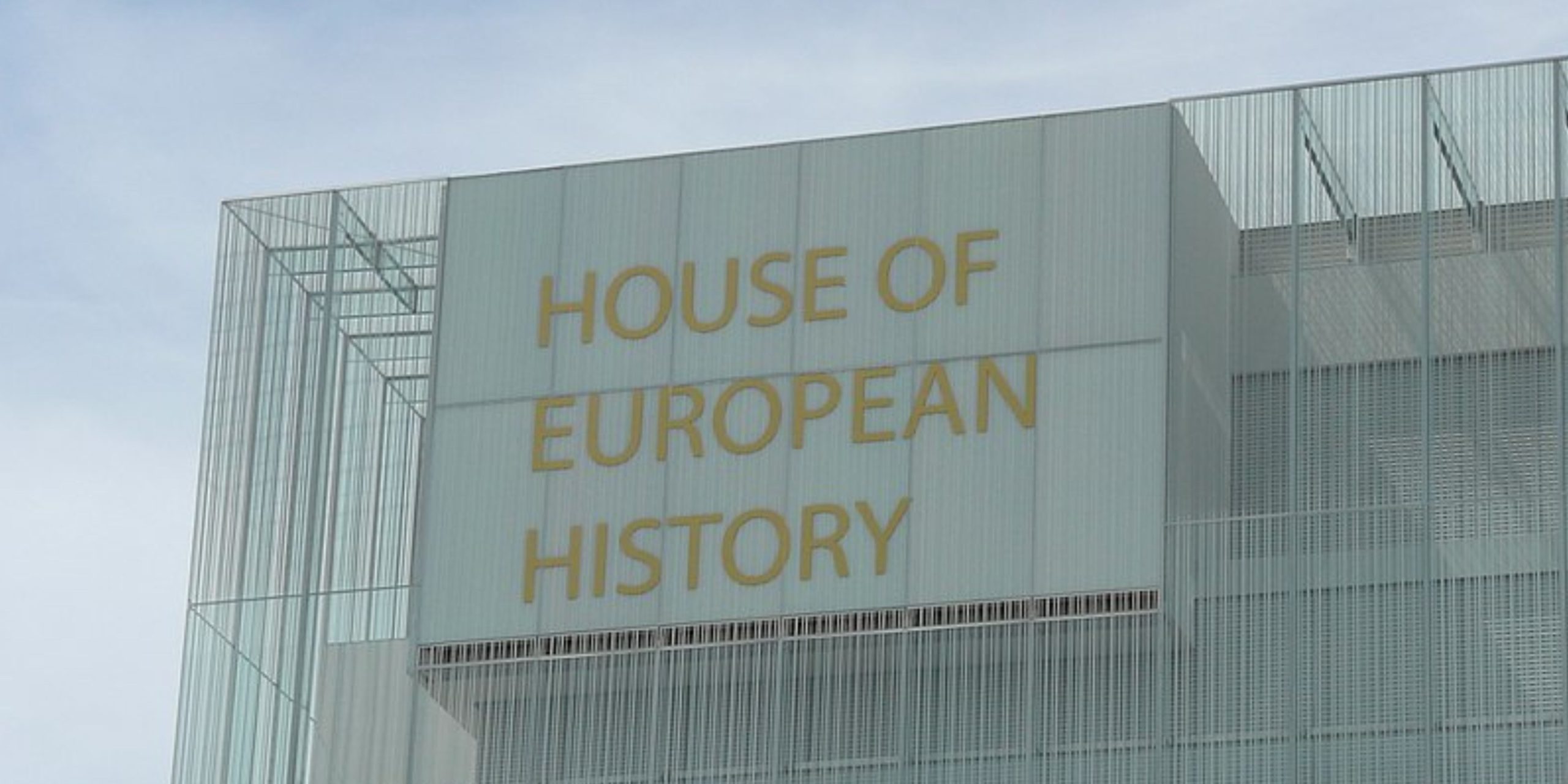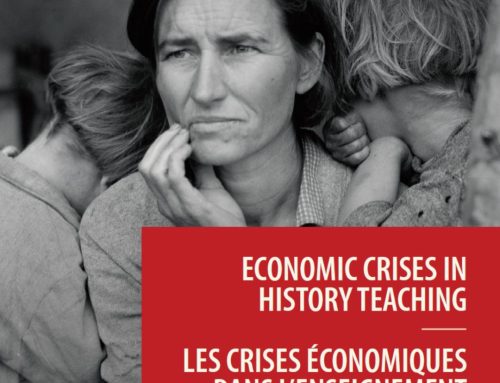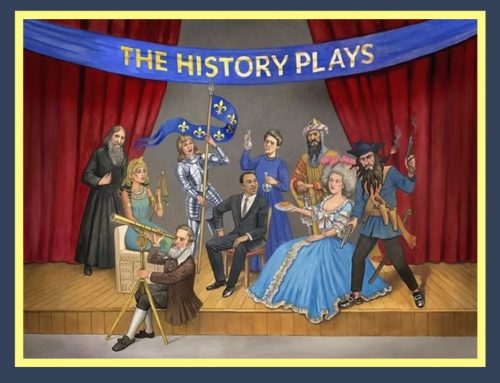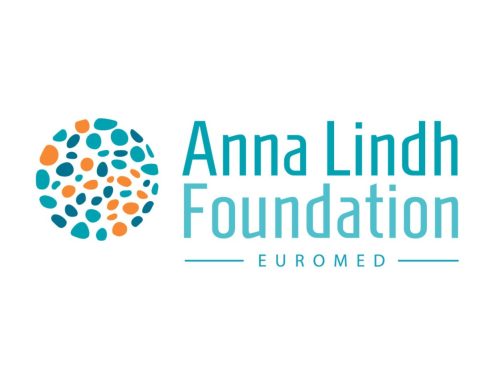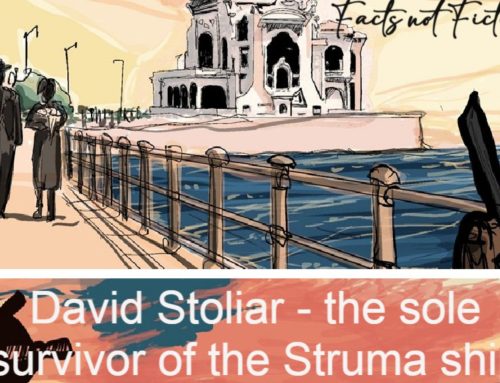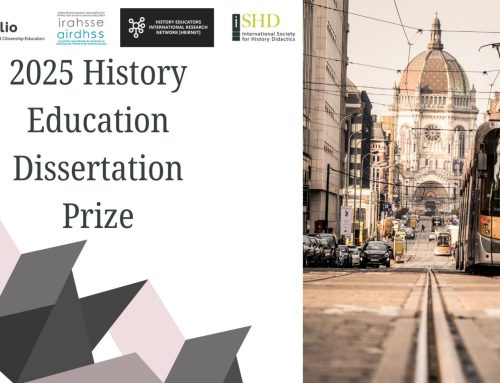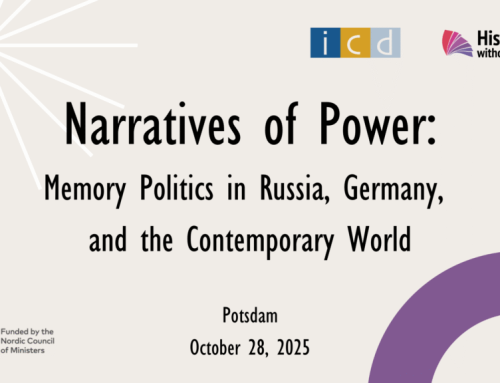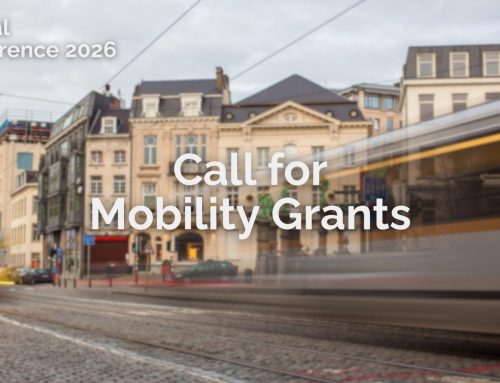Europe. One continent. One space. One community. A “melting pot” of civilisations.
So many epithets and meanings could be chosen to define it!
Yet, both yesterday and today, it is a stage that shares and integrates different people, ideas, languages, and cultures. A scenario of inclusiveness. A place where different peoples have converged over the centuries (and continue doing so…), leaving an unmistakable heritage that has helped to shape nations, states and institutions with distinctive features, their own communities, and identities. To value a multicultural space, which we want to be united by ties of solidarity, peace, and development, is one of the principal aims of the contemporary society. In fact, Europeans and non-Europeans together have all helped to create their roots. The most ancient roots, with unions and disunions, with wars and conflicts. All, equally, were at the genesis of a common European heritage that must be maintained and preserved to guarantee peace and stop the radicalisms that have arisen today and that threaten freedom, equality, and fraternity among all.
It is this heritage, in its material and immaterial aspects, which was the central basis for the creation the Museum of the House of European History, in Brussels (Belgium), which opened in 2017. An innovative and bold project – we must emphasise this – but one which illustrates the testimony of a continent that, since time immemorial, has jointly gone through a mosaic of adversities. Despite the cultural differences of its populations, the various setbacks of the European historical development were important in creating a collective memory and vision, defending the banner of peace, and an economic, political, and social cohesion that would give rise first to the EEC (European Economic Community), a few years after World War II, and later to the European Union (EU). The community formed transcends the simple geographic sphere, intending more and more to “include” all citizens of the world, under the aegis of freedom, democratic values and the “dream” of a “peace” that should prevail among all peoples and cultures.
In fact, these ideals are the fundamental pillars of the European Union and were intended to be embodied in what we metaphorically call in this article “a set of small slices of a larger cake”, that is, a set of artefacts chosen to be displayed in a chronological and representative sequence, and which constitute the visitable collection of the House of European History.
The museum and its collection begin with the foundational myths linked to the Phoenician princess Europa, kidnapped by Zeus: the Greek divinity who, disguised as a white bull, took her to Crete to consummate his passion – an island in the Mediterranean that is considered the cradle of the first great Western civilisation, the Minoan (2700-1500 BC). Therefore, such legend, justifies, in the opinion of Greek classic authors, like Herodotus, the name by which the continent we inhabit started to be known: Europe. The temporal frieze then leads us through a whole set of historical processes that help us reflect on our conscience and historical-cultural memory, looking at them in their multiple chronological fields. Thus, the reference to the Athenian democratic regime of the 5th century BC, imperfect but innovative for the time (and which would only be definitively consolidated in the second half of the 20th century in the Western world), makes sense. There is, however, a startling lack of references to the role that Rome played in the forging of our European identity. Just like the formation of the first Christian Germanic kingdoms, after the collapse of the Western Roman Empire, which were at the genesis of the current states and nations and in the creation of cultural differences that greatly mark Europe today.
After various secular vicissitudes and transformations that it is not important to mention here, between wars, famines, pestilences, or other large-scale transformations (from the phenomenon of Globalisation, which began with European Maritime Expansion, to the Industrial Revolution), we have arrived at a more recent, more present-day world, in which the collective memory is heightened by its more traumatic nature, a time that we can mark out between the end of Firsts World War and the disastrous consequences of Second World War. The museum gives special emphasis to this, namely due to the atrocities committed and the thousands of deaths caused by the last great conflict. There is a quote from Churchill in the exhibition that deserves to be highlighted: “We must all turn our backs upon the horror of the past. We must look to the future”. At first sight, we might find the sentence paradoxical. If it is by looking to the past that we understand the present and plan a better future, does that maxim make sense? The phrase obviously has a concrete historical context, and we cannot forget it. The loss of human life was enormous, the suffering and destruction reached levels never seen before during Second World War. We had to look to the future, we had to look at the problems Europe faced at that time and find workable solutions. Solutions that made possible, without much delay, what is today the European Union.
Just as in the last century, now, in the 21st century, we also face another type of upheaval that threatens peace and stability: the issues of migrations, populisms and radicalisms that, cyclically, tend to resurface in moments of collective crisis. Stages in the tour represented by symbolic artefacts by symbolic artefacts that deserve one’s attention, because they challenge the Universal Declaration of Human Rights, a document in which the European project was based.
In almost all the pieces in the House of European History that illustrate the marks of Europe’s Contemporary past (i.e. from 1789 onwards), the above-mentioned concepts are emphasised as they claim, for more troubled periods of the 19th, 20th and already 21st centuries, the right to civic participation, to self-determination of peoples and to life, as structuring words of citizenship and as extensions of freedom, equality and fraternity of citizens. These being structuring concepts, our focus fell precisely on the collection alluding to the French Revolution, exhibited on the third floor of the House of European History, for a more detailed examination.
The French Revolution marks the end of the Modern Period and the beginning of the Contemporary Age. We consider it to be the “kick-off” for the world and for the civic values that we know and value today. It began with the storming of the Bastille in Paris (a political prison and symbol of French royal absolutism and a whole privileged society), which was then destroyed by the Parisian people on 14th July 1789, today a bank holiday in France. There were horrific massacres at that event, such as the beheading of the Bastille governor himself, the Marquis de Launay, whose head was paraded through the streets of Paris on a spear! But this “Revolution” continues… no longer in the grotesque and violent manner of old. Rather, in the defende of democratic regimes through the call for civic participation, the defence of minorities and demonstrations aimed at mobilising public opinion against the most diverse attacks on the old revolutionary values that remain in the collective unconscious.
From a civilisational point of view, the event should be seen as a turning point in the history of humanity, which began in Europe (hence the exhibition’s clearer focus from 1789 onwards) and would eventually spread to other continents, such as the Americas (although the Revolution of the North American colonies in 1776 was an inspiration for the French Revolution). It was the sovereignty of the people that spoke the loudest, who desired change and greater power of civic participation. It wanted the aforementioned “equality, liberty and fraternity”, ideals that would forever mark the Revolution and that indelibly remain, and should remain, within the European Union and its citizens, not only as a slogan fighting against the oppression of peoples, but also as expressions that should represent and promote the integration and multiculturalism that today mark the European continent and the European community.
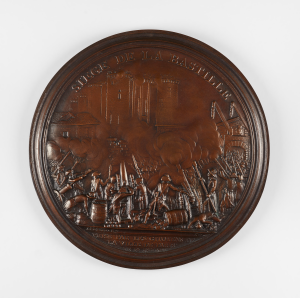
“Siege de la Bastille” (Storming of Bastille)
Paris, France, 1970, after Jean-Bertrand Andrieu (1761-1822). Enlarged medal in cast bronze. Monnaie de Paris, Paris, France
In the collection presented to us in the exhibition, there is a bronze medal, dated 1970, made in Paris, but a copy of another smaller one by Jean-Bertrand Andrieu (1761-1822). The medal depicts the storming of the Bastille and has a commemorative character, very reminiscent of identical artefacts from Roman times and which had the same function.
Unfortunately, it is the only piece concerning the period between 1789 and 1799 in the context of the collection on the French Revolution since the emphasis then passes on to the influence of revolutionary ideals of revolutionary ideals throughout the continent during the Napoleonic Empire and its end with the rise of nationalism.
Carved in bas-relief, the piece represents the storming of the Bastille on 14th July 1789. The people come together, wrapped in arms, with the soldiers, to destroy the prison, which catches fire and goes up in a cloud of smoke, representing the end of an era of inequality. Here an interesting metaphor might occur to the reader: if the taking of the Parisian political prison in 1789 was a symbol for the French population of the end of an era, can we not, we as European or non-European citizens, envisage this artefact as a memory that the house of European history wishes to keep alive among all those who visit it? A historical memory of the successes and failures of revolutions that certain objects tend to revive at every moment almost as if the conquests of the past could not be taken for granted? Memory is built on the past, so History is Memory. Freedom, equality, and fraternity cannot be taken for granted. They cannot be mere symbols of a past memory. Today’s world shows us that the “revolution” did not end in 1789. It has acquired, rather, other contours that oblige us to consolidate, every day, those conquests.
Written by Ricardo Fernando Gomes Pinto e Chaves (Portugal) in connection with EuroClio’s training course “Writing History” at the House of European History in Brussels, May 2023.
Discover our members' review of the House of European History
We have asked participants to review the Permanent Exhibition of the House of European History for their colleagues. You can now view reviews in the following languages:

